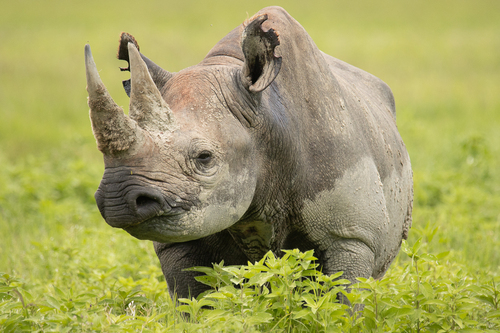
Black Rhinoceros
Diceros bicornis, or the black rhinoceros, roams African savannas with a distinctive hooked lip and prominent double horns. Solitary and keen-sensed, they shape their ecosystem by pruning vegetation. Despite their name, they're not black but grey, and are critically endangered due to poaching.
45-50 years
Lifespan
800.0 - 1400.0 kg
Weight
Length: 3.3 - 3.6 m
Size
Brown, Grey, White
Color
40 mph
Top Speed
Critically Endangered
Conservation Status
Increasing
Population Trend
Characteristics
The Diceros bicornis, commonly known as the black rhinoceros, is a large herbivore native to the savannas and grasslands of Eastern and Southern Africa. It is noted for its hooked lip, which is adapted for grasping leaves and twigs. Despite its name, it is not truly black but varies from brown to grey. This rhino is distinguished by its two horns, with the anterior horn being more prominent. Black rhinos are solitary creatures, known for their keen sense of smell and hearing, which compensate for their poor eyesight. They play a crucial role in their ecosystem by influencing vegetation structure and serving as a key species in their habitats. Unfortunately, they are critically endangered due to poaching and habitat loss.
Distribution Range of the Black Rhinoceros
Diceros bicornis, commonly known as the black rhinoceros, is native to eastern and southern Africa. Its geographical distribution historically included a wide range across sub-Saharan Africa, but due to habitat loss and poaching, its range has significantly contracted. Currently, substantial populations can be found in countries such as Namibia, South Africa, Kenya, Tanzania, and Zimbabwe.
Black Rhinoceros's Habitat
Environmental Conditions
The black rhinoceros inhabits a variety of environments, ranging from savannas, grasslands, and shrublands to deserts. It prefers areas with dense, woody vegetation which provides both cover and food. The climate in these regions can vary from semi-arid to subtropical, with distinct wet and dry seasons.
Ecological Niche
As a browser, the black rhinoceros primarily feeds on leafy plants, branches, shoots, thorny wood bushes, and fruit. Its prehensile upper lip is well-adapted to grasping and manipulating vegetation. The species plays a crucial role in its ecosystem by influencing the structure of vegetation and contributing to biodiversity. Regional adaptations may include variations in diet and behavior based on the availability of resources.
Copyright @ Nature Style Limited. All Rights Reserved.
 English
English